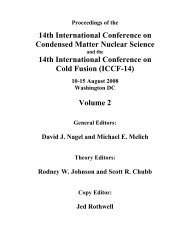Transmutation of metal at low energy in a confined ... - LENR-CANR
Transmutation of metal at low energy in a confined ... - LENR-CANR
Transmutation of metal at low energy in a confined ... - LENR-CANR
You also want an ePaper? Increase the reach of your titles
YUMPU automatically turns print PDFs into web optimized ePapers that Google loves.
4. Experimental evidence<br />
Fig. 11. View <strong>of</strong> the plasma he<strong>at</strong> transfer mechanism<br />
Once a stable plasma has been achieved for more than 500 sec., we can compare the <strong>in</strong>put <strong>energy</strong>,<br />
electrical power, with the quantity <strong>of</strong> <strong>energy</strong> necessary to warm up and evapor<strong>at</strong>e the solution<br />
w<strong>at</strong>er. Omitted from this calcul<strong>at</strong>ion is <strong>energy</strong> associ<strong>at</strong>ed with chemical reactions; <strong>energy</strong> rel<strong>at</strong>ed to<br />
the he<strong>at</strong><strong>in</strong>g-up and fusion <strong>of</strong> the tungsten; <strong>energy</strong> used <strong>in</strong> expand<strong>in</strong>g gas and steam leav<strong>in</strong>g the cell;<br />
<strong>energy</strong> lost by thermal and electromagnetic radi<strong>at</strong>ion; and loss <strong>of</strong> he<strong>at</strong> through the <strong>in</strong>sul<strong>at</strong>ion. Even<br />
though this extra <strong>energy</strong> is omitted from the calcul<strong>at</strong>ion, the cell is found to produce more <strong>energy</strong><br />
than is be<strong>in</strong>g applied. If the <strong>energy</strong> needed to warm-up the electrolyte to 100°C and then produce<br />
evapor<strong>at</strong>ion is taken <strong>in</strong>to account, values <strong>of</strong> output/<strong>in</strong>put = 1.2 to 1.4 are obta<strong>in</strong>ed.<br />
Us<strong>in</strong>g an SEM (scann<strong>in</strong>g electron microscope), the presence <strong>of</strong> rhenium, osmium, gold, hafnium,<br />
thulium, erbium, and ytterbium are found on the surface <strong>of</strong> the c<strong>at</strong>hode. These elements were not<br />
previously <strong>in</strong> the appar<strong>at</strong>us (see Fig. 12, 13, 14).












